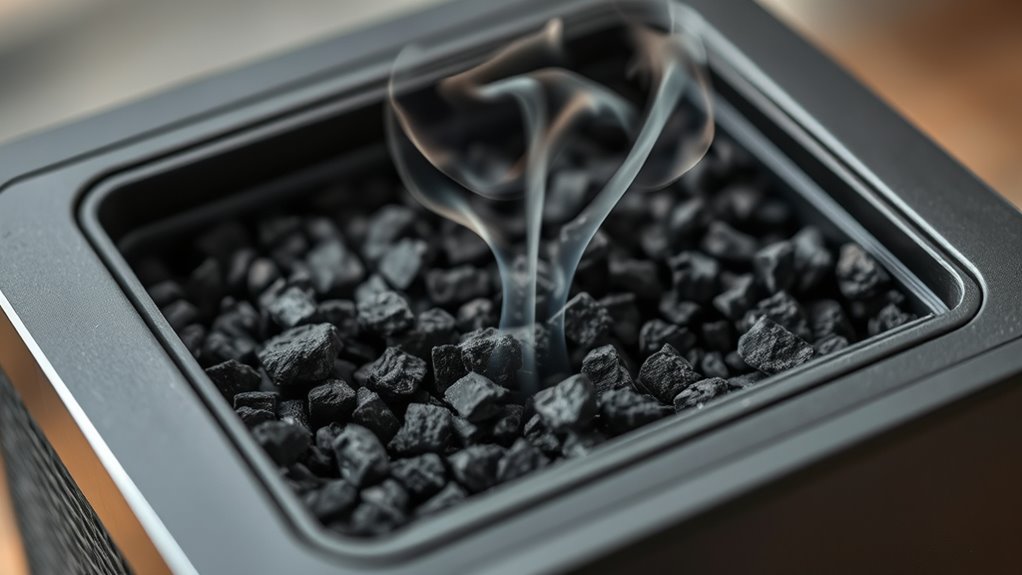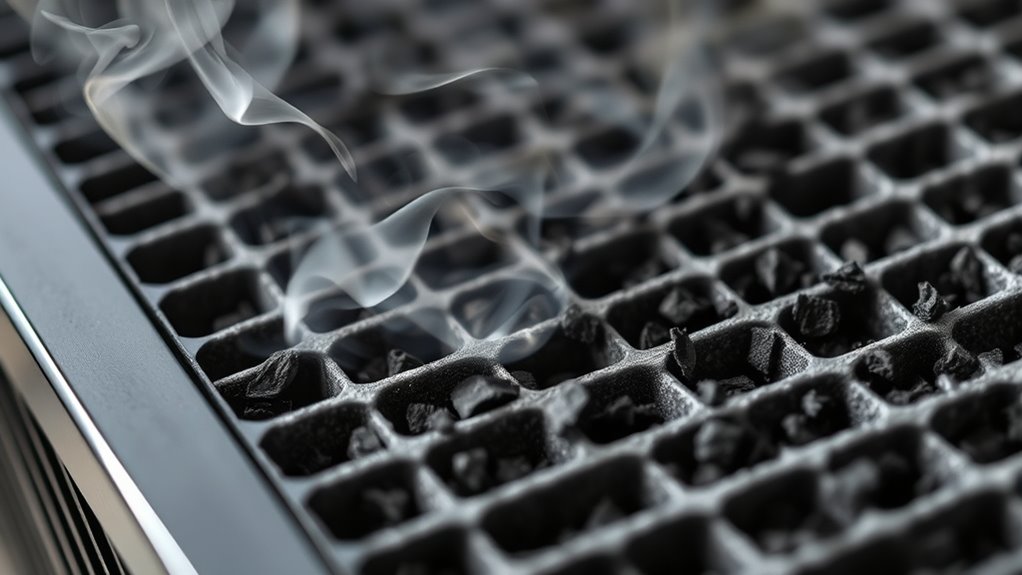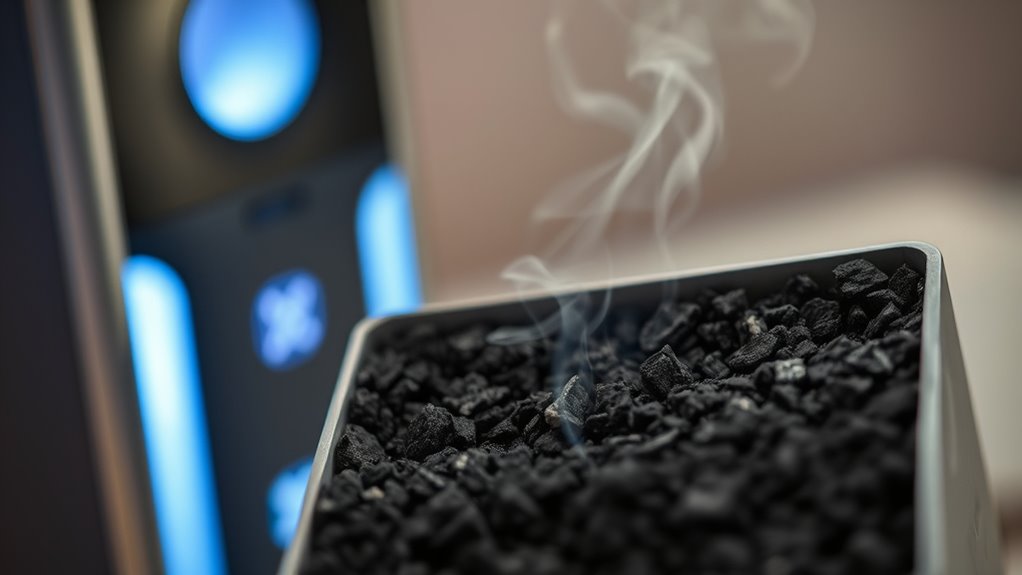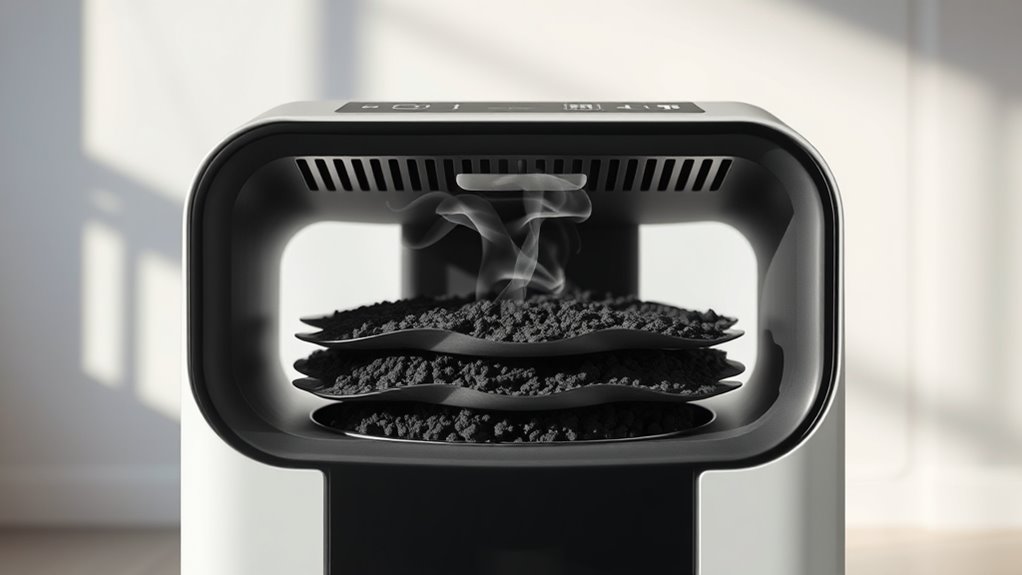Charcoal inserts are effective at reducing smoke, odors, and VOCs in your indoor air thanks to activated carbon’s highly porous structure and large surface area. They trap harmful molecules through adsorption, making them a good choice for odor control. However, their performance depends on proper maintenance and replacement, as saturation decreases their effectiveness over time. If you want to learn more about maximizing charcoal’s odor-fighting power, continue exploring the details below.
Key Takeaways
- Charcoal inserts effectively adsorb smoke and odors due to their porous activated carbon structure with high surface area.
- They trap volatile compounds like VOCs, formaldehyde, and benzene, improving indoor air quality.
- Proper maintenance and timely replacement are essential, as saturation reduces their odor and gas absorption capacity.
- Combining charcoal filters with other technologies like HEPA or UV enhances overall smoke and odor removal.
- They are less effective against particulate matter but excel at removing gases, fumes, and non-polar odors.
How Charcoal Inserts Absorb Odors and Gases

Charcoal inserts absorb odors and gases by using activated carbon’s highly porous structure to trap molecules through surface adhesion. When odors or gases like formaldehyde, benzene, or cigarette smoke pass through the insert, activated carbon’s surface captures these molecules via adsorption. Its extensive surface area—up to 32,000 square feet per gram—enhances this process, allowing it to effectively trap contaminants. The small pores in the activated carbon enable physical adsorption of volatile compounds and non-polar molecules, preventing them from dispersing into the air. Additionally, the effectiveness of charcoal inserts can be influenced by the material’s porosity, which determines how much surface area is available for adsorption. The efficiency depends on factors like pore size, surface area, and the density of the activated carbon in the insert. For optimal performance, it’s important to ensure the quality of the charcoal used is high, as lower-quality options may have reduced porosity and surface area. Proper manufacturing processes are crucial for maintaining the charcoal’s effectiveness and consistency. Regular replacement of the inserts is necessary because adsorption capacity diminishes over time as the charcoal becomes saturated. Moreover, the type of pollutants present in the environment can influence how well charcoal filters perform, as some gases are more readily captured than others. While charcoal inserts excel at capturing certain gases, they’re less effective against particulate matter or polar gases.
The Science Behind Activated Carbon Filtration

Activated carbon’s porous structure provides an immense surface area, allowing it to trap gases and odors effectively. When pollutants come into contact with the internal pores, they adhere through the adsorption process, capturing contaminants like VOCs and acids. This filtration method is especially effective against non-polar gases and odors but doesn’t remove particulate matter. Additionally, advancements in automation technologies are enhancing the manufacturing and deployment of activated carbon filters. The design of wickless candles and other innovative candle-making techniques reflect ongoing efforts to create cleaner, soot-free products that complement effective air purification methods. Proper maintenance and replacement of activated carbon filters are crucial to ensure their continued effectiveness in air quality management. The development of regenerative filtration techniques is also contributing to more sustainable and cost-effective air purification solutions.
Porous Structure and Surface Area
The effectiveness of activated carbon in filtering smoke and odors largely depends on its porous structure and extensive surface area. Its porous structure results from high-temperature treatments that create millions of tiny pores, dramatically increasing its surface area. This large surface allows the carbon to adsorb a wide variety of gaseous pollutants. For example, just 1 gram of activated carbon can have up to 32,000 square feet of surface area, providing numerous active sites for molecules like VOCs and odors to adhere. The table below highlights the relationship between surface area and adsorption capacity:
| Surface Area (sq ft/gram) | Pollutant Types | Adsorption Efficiency |
|---|---|---|
| 32,000 | Gases, VOCs, odors | Very high |
| 15,000 | Larger molecules | Moderate |
| 5,000 | Particulates | Lower |
This vast surface area makes activated carbon highly effective in trapping pollutants.
Adsorption Mechanism Explained
The porous structure and extensive surface area of activated carbon are key to its ability to filter pollutants effectively, but understanding how it captures gases and odors requires examining the adsorption process itself. Adsorption occurs when molecules, like VOCs and odors, adhere to the surface of activated carbon’s tiny pores. Unlike absorption, where molecules go inside the material, adsorption keeps contaminants on the surface, making it ideal for gas filtration. The large surface area—up to 32,000 square feet per gram—provides countless sites for trapping pollutants. The effectiveness of activated carbon depends on pore size and surface chemistry, with larger pores better suited for bigger gas molecules. This process enables activated carbon to remove odors and gases efficiently, making it a powerful filtration tool. Additionally, the quality of ingredients and manufacturing processes can influence the overall performance of activated carbon filters. Properly maintained, activated carbon can be regenerated or replaced to sustain its filtration effectiveness, which is also influenced by pore size and surface chemistry. The adsorption capacity of activated carbon can vary depending on the specific application and environmental conditions.
Contaminant Removal Capabilities
Ever wondered how activated carbon efficiently removes contaminants from smoke and odors? It all comes down to adsorption, where gaseous molecules stick to the large surface area of activated carbon’s porous structure. One gram of activated carbon can have up to 32,000 square feet of surface, providing ample space for trapping harmful chemicals. The pores trap volatile organic compounds (VOCs), formaldehyde, benzene, and other toxins found in smoke and odors. The removal process depends on pore size, surface area, and surface functional groups that attract specific molecules. Activated carbon primarily targets non-polar molecules, making it highly effective against odors and VOCs. However, it’s less effective for particulate matter like dust or pollen, which require different filtration methods. Additionally, the effectiveness of activated carbon can be influenced by the digital literacy and maintenance practices of users, ensuring optimal performance over time. Proper filter replacement is essential to maintain its contaminant removal capabilities and prevent saturation that reduces efficiency. Ensuring proper air flow can also enhance the filtration process and maximize contaminant removal.
Effectiveness of Charcoal for Smoke and Odor Removal

Activated charcoal filters are highly effective at removing smoke odors and gaseous pollutants because of their porous structure and large surface area. This Activated Carbon traps Odors and VOCs through adsorption, capturing gases that cause persistent smells. Studies show that charcoal inserts can reduce cigarette smoke odors by up to 80% when you replace them regularly and keep them well-maintained. Their effectiveness depends on factors like pore size, surface area, airflow, and how long they’re used. Charcoal filters work best on non-polar compounds such as benzene and formaldehyde, making them ideal for smoke and chemical odors. However, they’re less efficient at trapping particulate matter. To maintain their performance, you need to replace the filters regularly, as their adsorption capacity diminishes over time. Incorporating air quality management can further enhance the efficiency of your overall air quality management. Additionally, understanding celebrity lifestyle insights can inspire innovative ways to improve everyday environments, such as incorporating stylish home decor that complements air purification systems. Regular maintenance and understanding filter lifespan are crucial to ensure continued effectiveness of charcoal filters.
Factors Influencing Charcoal Filter Performance

The performance of your charcoal filter depends heavily on pore size and surface area, which determine what gases and odors it can trap effectively. Regular maintenance and timely replacement are essential because a saturated filter loses its ability to adsorb odors. Understanding these factors helps you choose and care for your filter to keep it working at its best. Additionally, incorporating sound healing science principles, such as specific frequencies and vibrations, may enhance the overall effectiveness of your environment by promoting relaxation and cellular regeneration. It is also beneficial to consider filter lifespan and how environmental factors can influence its durability and performance over time. Proper knowledge of hepa filter efficiency can further guide you in selecting the most effective filtration system for your needs. Recognizing the impact of environmental conditions can also help optimize filter performance and longevity, ensuring cleaner indoor air.
Pore Size and Surface Area
Pore size and surface area are crucial factors that determine how well a charcoal filter performs in removing smoke and odors. The pore size, usually between 0.2 to 2 nanometers, affects how effectively the filter adsorbs tiny gas molecules from smoke and VOCs. Smaller pores are better for trapping gases, while larger pores handle bigger molecules. A higher surface area, often exceeding 32,000 square feet per gram, provides more active sites for adsorption, boosting the filter’s capacity to trap contaminants. The balance between micropores and mesopores ensures ideal performance for different pollutants. Ultimately, a larger surface area combined with the right pore size distribution makes the charcoal more efficient at eliminating unwanted odors and harmful gases.
Filter Maintenance and Replacement
Maintaining and replacing charcoal filters regularly is essential to guarantee they continue to effectively remove odors and VOCs. Activated carbon’s surface area, which can reach up to 32,000 sq ft per gram, determines its adsorption capacity. Over time, pore blockage from trapped contaminants reduces this effectiveness, so filter replacement every 3 to 6 months is recommended. Factors like airflow rate, humidity, and contaminant levels speed up saturation, requiring more frequent changes. Proper maintenance means monitoring air quality and odors—if they persist, it’s time to replace the filter. Using high-quality activated carbon with good porosity enhances longevity and odor control. Regular filter replacement keeps your system working efficiently, ensuring cleaner, fresher air.
Comparing Charcoal Inserts to Other Air Purification Methods

Charcoal inserts, especially activated carbon filters, are highly effective at removing gases, VOCs, and odors thanks to their extensive porous surface area. They excel at targeting gaseous pollutants and odors but don’t considerably reduce particulate matter like smoke or dust. Compared to HEPA filters, which are designed to capture particles, activated carbon air filters focus on gaseous contaminants. Combining both types offers a more complete solution by removing particles and odors simultaneously. However, the effectiveness of charcoal inserts depends on their quality, surface area, and maintenance. While alternative methods like ozone generators or chemical neutralizers can supplement activated carbon, they may pose health risks or leave residues. Overall, activated carbon remains a key component for odor control but works best when integrated into multi-stage air purification systems.
Proper Placement and Usage of Charcoal Filters

To maximize the odor and gas removal benefits of charcoal filters, you need to place them directly in the airflow path, such as inside air purifiers or near vents. Proper placement guarantees filters help absorb pollutants effectively. Consider these tips:
Maximize charcoal filter effectiveness by placing them directly in airflow paths like purifiers or vents for optimal odor removal.
- Position filters inside air purifiers or near vents to increase contact with smoke and odors.
- Make sure the filter is securely fitted and oriented as per manufacturer instructions to avoid air bypass.
- Regularly replace or recharge charcoal inserts every 3 to 6 months to maintain efficiency.
- In HVAC systems, place filters at intake or return vents for even distribution of purified air.
Strategic placement, combined with proper sealing and maintenance, maximizes the filters’ ability to remove smoke and odors efficiently.
Maintenance and Replacement of Charcoal Inserts

Regular replacement of charcoal inserts is essential to keep your air purification system working effectively. Activated carbon in the inserts absorbs odors and VOCs, but its capacity diminishes over time. Typically, you should replace the charcoal filter every 3 to 6 months to maintain peak performance. Keep an eye out for persistent odors or reduced air quality, as these signs indicate it’s time for a new filter. Proper disposal of used charcoal inserts is important since they contain trapped chemicals from smoke and pollutants. Always check manufacturer guidelines for specific replacement intervals, especially in environments with heavy smoke or VOC emissions. Additionally, maintaining clean pre-filters and ensuring unobstructed airflow help prolong the effectiveness and lifespan of your charcoal inserts.
Limitations of Charcoal Filters in Odor Control

While activated carbon filters are effective at capturing many odors and VOCs, they have notable limitations when it comes to eliminating strong or persistent smells. Their ability to adsorb odors depends on pore size and surface area, which may allow some odor molecules to slip through. Here are key limitations:
Activated carbon filters can struggle with strong or persistent odors due to pore size and surface limitations.
- They often struggle with intense or complex odors, like cigarette smoke.
- Activated carbon primarily targets non-polar molecules, making it less effective against polar compounds such as ammonia.
- Over time, the porous surface becomes saturated, decreasing odor absorption and requiring regular replacement.
- Larger pores can reduce efficiency, allowing certain odors to pass through more easily.
Understanding these limits helps you manage expectations about charcoal filters’ performance in controlling stubborn odors.
Enhancing Odor Removal With Additional Filtration Technologies

To improve odor removal, you can combine multiple filtration layers, like activated charcoal with HEPA filters, to target gases and particles more effectively. Upgrading to advanced gas technologies, such as bipolar ionization, helps reduce VOCs without ozone risks. Adding extra stages like UV sterilizers or pre-filters further boosts odor control and extends filter life.
Combining Multiple Filtration Layers
Combining multiple filtration layers substantially boosts odor removal by targeting different types of pollutants at once. By using multi-layer filtration, you can enhance the effectiveness of activated carbon filters and better neutralize complex odors. For example:
- Adding a MERV-rated pre-filter captures larger particles, preventing clogging and extending filter life.
- Placing a HEPA filter after the carbon layer traps fine particulate matter like pet dander and smoke particles.
- Integrating technologies such as bipolar ionization or UV sterilization can break down VOCs and neutralize odors more completely.
- Combining these layers can reduce odors by up to 90%, far surpassing single-filter systems, and effectively targets pollutants from cooking, pets, and smoking.
Upgrading Odor Absorption Capacity
Upgrading your odor absorption capacity involves incorporating advanced filtration technologies that work alongside activated charcoal to improve overall effectiveness. Adding HEPA or photocatalytic filters can target both gaseous pollutants and particulate matter, boosting odor absorption. Combining activated charcoal with ionizers or ozone generators enhances odor neutralization but requires careful regulation to avoid ozone-related health risks. Upgrading from basic charcoal inserts to high-capacity V-Bank or pleated filters increases the surface area for odor absorption, making your system more efficient and longer-lasting. Multi-layer systems that include activated carbon, pre-filters, and UV sterilization further improve odor removal while reducing VOCs and airborne pathogens. Regularly replacing or regenerating filters maintains *superior* odor absorption, preventing saturation and preserving filter performance over time.
Integrating Advanced Gas Technologies
Integrating advanced gas technologies like photocatalytic oxidation and plasma filtration can remarkably enhance your odor removal capabilities. These methods go beyond traditional activated carbon filters, breaking down VOCs and gases into harmless compounds. Consider these options:
- Use photocatalytic oxidation to degrade complex odors and persistent fumes more effectively.
- Combine activated carbon with ozone-free bipolar ionization for VOC and odor removal rates over 90%.
- Implement UV photo-oxidation or plasma filtration systems to improve overall air purification and gas removal.
- Opt for multi-technology filters that blend adsorption and catalytic oxidation, tackling a broader range of odors and chemical fumes.
Adding sensors and smart controls further optimizes these systems, ensuring maximum efficiency in gas removal and odor control.
Choosing the Right Charcoal Filter for Your Needs

Choosing the right charcoal filter depends on understanding your specific air purification needs. Activated carbon filters with higher porosity and larger surface areas—up to 32,000 sq ft per gram—are more effective at adsorbing smoke and odors. Pay attention to pore size; smaller pores are better at trapping gases and volatile compounds, making them ideal for odor control. For thorough air purification, consider combining charcoal inserts with HEPA filters, which target particulate matter. Also, check the filter’s capacity, lifespan, and compatibility with your ventilation system to guarantee ideal performance. Selecting a charcoal filter tailored to your needs ensures better removal of smoke and odors, improving your indoor air quality efficiently and effectively.
Frequently Asked Questions
Will Charcoal Filters Remove Smoke Smell?
You’re wondering if charcoal filters will remove smoke smell. The answer is yes; they’re highly effective because the activated carbon traps odor-causing molecules through their porous structure. When used in air purifiers or filters, they can reduce smoke odors markedly, often up to 90%. Just remember to replace them every 3 to 6 months to keep their odor-absorbing power strong, especially when dealing with persistent smoke smells.
Do Charcoal Air Filters Actually Work?
You’re wondering if charcoal air filters actually work. The answer is yes, they’re highly effective at removing gases, odors, and VOCs from indoor air. They work through adsorption, trapping airborne pollutants on their large surface area. Just keep in mind, they don’t filter out dust or pollen, so you might need a HEPA filter for that. Regular replacement and proper maintenance will guarantee they continue to do their job effectively.
Do Charcoal Odor Absorbers Work?
You’re wondering if charcoal odor absorbers work. They do, by trapping odor molecules on their porous surface, which can substantially reduce smells like smoke, pets, and cooking in your home. The key is that they work quickly and effectively, but their capacity depends on factors like surface area and odor concentration. Remember to replace or reactivate the charcoal regularly to keep odors at bay.
What Is the Disadvantage of a Charcoal Filter?
The main disadvantage of a charcoal filter is that it can become saturated over time, which reduces its ability to absorb odors and gases effectively. When it’s not replaced regularly, it may even release trapped pollutants back into the air. Additionally, lower-quality filters might produce dust or residue as they degrade, and they don’t remove particulate matter like dust or pollen, which limits their overall air-cleaning capabilities.
Conclusion
In the end, charcoal inserts can be a gentle touch in your air’s journey to invigorating. They quietly work behind the scenes, soaking up the unwelcome hints and leaving a more inviting atmosphere. While they’re not a magic wand, with a little care and the right choices, you can create a space that feels lighter and more welcoming. Think of it as giving your air a subtle, revitalizing breath of new life.









